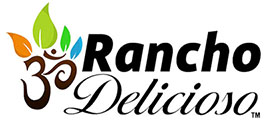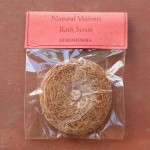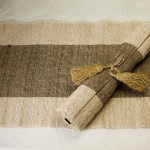Vetiver Grass in Costa Rica – Zacate Violeta
Vetiver Grass, known here as Zacate Violeta “Purple Grass” is one of the world’s most useful and essential plants, and an essential component of sustainable living. Originally from India, it many hundreds of years ago, it spread to other parts of Asia, where it was discovered to be very useful for erosion control. It’s now used for that purpose around the world, and in Costa Rica. When used for construction purposes, such as retaining a slope after a landslide, it’s cost is about 5% that of standard techniques such as covering a hillside with concrete.
In one local instance, a house we were managing in Delicias, Casa Verde, had a small landslide, and two or three engineers/builders who saw it said that the only way to repair it and prevent future erosion was to build a concrete retaining wall, with various price quotes from $12,000 to $20,000. Instead of listening to the “experts”, we planted vetiver grass that we got for free from my Solar Vista eco village project in Malpais. With labor and transport, the total cost to solve the problem was less than $200!
Vetiver for Erosion Control
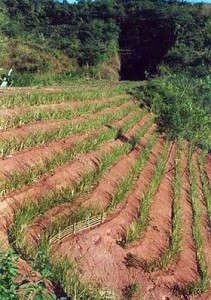 In Costa Rica and most tropical countries, one can find vetiver used along steep slopes to prevent erosion. It’s dense and deep vertical root system penetrates dense soils and creates a near-impenetrable barrier that both prevents landslides and prevent soil erosion.
In Costa Rica and most tropical countries, one can find vetiver used along steep slopes to prevent erosion. It’s dense and deep vertical root system penetrates dense soils and creates a near-impenetrable barrier that both prevents landslides and prevent soil erosion.
Used in a permaculture setting, it’s often grown along a contour lines on a slope, and acts like a net to catch any topsoil that’s washed away during the rains. Hedges of vetiver thus tend to build up good soil behind them.
In addition, the deep roots of this plant can act as a sponge, holding water underground that can be accessible to other plants in the dry season, much like a hugelculture system, but a lot easier to set up, and it works well on a slope, which we have lots of at Rancho Delicioso and around this part of Costa Rica.
Using vetiver for erosion control is not merely a a cheap substitute for doing it with concrete. Vetiver is the only correct method, in that it’s not just cheaper, but far superior as well. Using concrete on the side of a hill is just ignorant in situations where this grass can be used instead. Unfortunately, politics being what they are, the cheapest, most effective solution isn’t always the one that generates the most revenue, commissions, and bribes to officials who may favor a solution that enriches their uncles’s construction company at the expense of the public.
Planting and Growing Vetiver
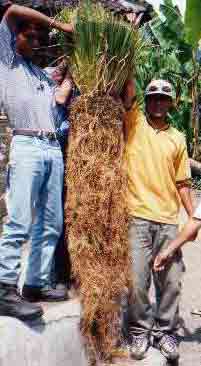 Vetiver grows in clumps, but it doesn’t spread or seed, so it’s non-invasive and tends to stay right where you put it. It’s been reported that rows of it planted 60 years ago in some places have hardly changed.
Vetiver grows in clumps, but it doesn’t spread or seed, so it’s non-invasive and tends to stay right where you put it. It’s been reported that rows of it planted 60 years ago in some places have hardly changed.
You can cut a part of this grass away, taking some of the roots with it, and replant it, and it will grow into a new clump around 50-80cm wide, and after that, like magic it just stops growing. So because of this it’s really easy to get plenty of free vetiver from your own farm once you have enough established.
So, if you have a washout or even a large landslide, then a very effective way to solve this problem is just to plant horizontal rows of vetiver grass along it. You can plant it in the beginning of dry season, and if you irrigate it for 4-5 months it will establish itself well enough to resist the deluges of rainy season.
We have found that vetiver also is great in that it doesn’t need to be watered. Wherever we’ve planted it, it’s been able to survive indefinitely with no water at all during the five months of dry season. This is because it’s deep roots are able to tap into water below, and also they apparently trap their own water, which is why this plant works so well as a soil retaining wall in permaculture contour gardens.
Vetiver as Roof Thatch
 Vetiver is one of the best roof thatch materials, used around the world from Venezuela to Fiji. There are various techniques, but one method I read about what to cut it around 25cm from above the ground, then to weave it into longer strands that are around 2 meters long. These strands are sewn together to make sheets and are then laid on top of each other and bound to the wood frame of the house. Ideally, they should be 50cm thick, which sounds like it would take months to do, but when complete, a thatch roof of vetiver grass lasts for many years because it resists and repels insects, including termites. Not only does it repel bugs, but it repels heat, so is great for keeping the occupants cool inside.
Vetiver is one of the best roof thatch materials, used around the world from Venezuela to Fiji. There are various techniques, but one method I read about what to cut it around 25cm from above the ground, then to weave it into longer strands that are around 2 meters long. These strands are sewn together to make sheets and are then laid on top of each other and bound to the wood frame of the house. Ideally, they should be 50cm thick, which sounds like it would take months to do, but when complete, a thatch roof of vetiver grass lasts for many years because it resists and repels insects, including termites. Not only does it repel bugs, but it repels heat, so is great for keeping the occupants cool inside.
As far as I know, it’s not used now as a thatch material in Costa Rica. Most places prefer a type of palm frond that’s imported from Nicaragua, or the local “king palm” fronds. To me, it seems like the best quality option, but I doubt anyone in the area knows how to use it. It would be a good project for a volunteer to take on, to do some research and experiment to see how to use it in this way.
Other Uses of Vetiver
This amazing plant, like bamboo, has almost too many uses to count beyond it’s primary application as erosion control:
Essential Oil
-
- – vertiver oil is used both as a medicinal and in the perfume industry.
Grass hats, mats, etc – the material is very strong and resists bugs, so it’s great to make into various handicrafts
Pond Cleaning – it grows in pure water without soil, and so is used to remove nutrients from ponds that have become toxic, but floating it with pontoons.
Root Powder as Healing Remedy – the roots are ground into a powder and put on wounds to speed up healing.
Vetiver Resources
http://www.vetiver.org/ – International Vetiver Network – Tons of info and a forum for vetiver help/discussions.
Vetiver Wiki – Wikipedia article on Chrysopogon Zizanioides
